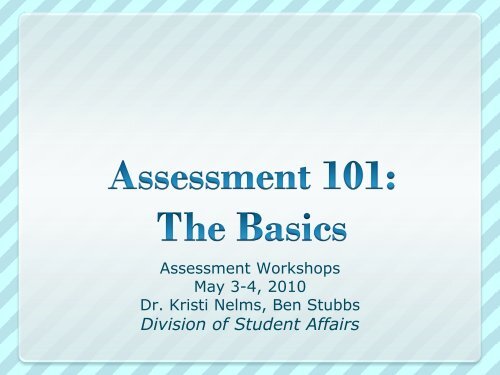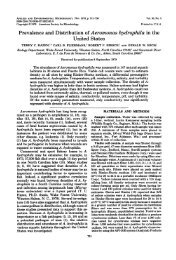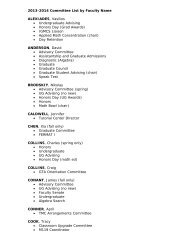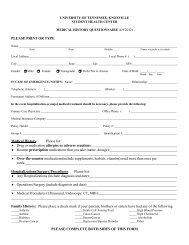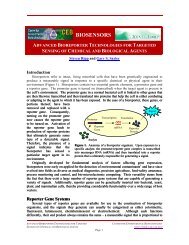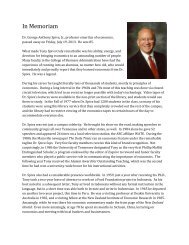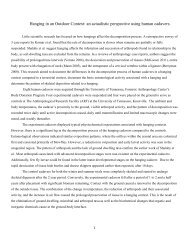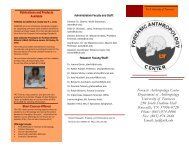Assessment 101: The Basics - Division of Student Life
Assessment 101: The Basics - Division of Student Life
Assessment 101: The Basics - Division of Student Life
You also want an ePaper? Increase the reach of your titles
YUMPU automatically turns print PDFs into web optimized ePapers that Google loves.
<strong>Assessment</strong> WorkshopsMay 3-4, 2010Dr. Kristi Nelms, Ben Stubbs<strong>Division</strong> <strong>of</strong> <strong>Student</strong> Affairs
DefinitionsModelASSESSMENTTraitsComponents
Session Outcomes• Understand what “assessment” meansand why we are doing it.• Define two characteristics <strong>of</strong> assessment.• Distinguish among the four types <strong>of</strong> datavariables.• Explain at least two statistical terms inconcise and accurate language.• Identify three elements <strong>of</strong> acomprehensive assessment model.
Focused Listing Exercise• What does the term“assessment” mean to you?• What synonyms come to mind when youhear the term “assessment”?
<strong>Assessment</strong> definition• . . .the systematic collection, review,and use <strong>of</strong> information aboutprograms/services undertaken forthe purpose <strong>of</strong> improving studentlearning and development. (adaptedfrom Palomba & Banta, 1999)
Definitions <strong>of</strong> <strong>Assessment</strong>Schuh & Upcraft (2001)• <strong>Assessment</strong> is any effort to gather,analyze, and interpret evidence whichdescribes institutional, divisional,(program,) or agency effectiveness• It includes...• assessment <strong>of</strong> student learning outcomes• assessment <strong>of</strong> cost effectiveness• assessment <strong>of</strong> “client” satisfaction• assessment <strong>of</strong> compliance with pr<strong>of</strong>essional standards• assessment <strong>of</strong> comparisons to other institutions• It is not restricted to assessment <strong>of</strong> students, butincludes assessment <strong>of</strong> faculty, staff,administrators, parents, employers, graduates ….
Definitions <strong>of</strong> <strong>Assessment</strong>(AAHE, 1995)• <strong>Assessment</strong> is an ongoing process aimedat understanding and improving studentlearning• It involves ...• making expectations RE learning explicit andpublic;• setting appropriate criteria and highstandards for learning quality;• systematically gathering, analyzing, andinterpreting evidence to determine how wellperformance matches those expectations andstandards; and• using the results to document, explain, andimprove learning and performance
Characteristics <strong>of</strong> <strong>Assessment</strong>SystematicData-drivenObjectiveTied to practiceContinuous
LimitationsTrueImpactOutsideinfluenceTime &Resource
Components <strong>of</strong> <strong>Assessment</strong>• What you wantto know• Who/what doyou want toknow about• How to measurewhat you need toknow
What you want to know•Needs•Satisfaction•Program and/orLearning Outcomes
Who/what do you want to knowabout?•Population• Examples?•Sample• Examples?
How to measure what you need• Operationalizevariables• Determinemethod• Developinstrument• Analyze data
Developing instrumentsSTEM RESPONSE DATA
DATAData types (NOIR)• Nominal (Male/Female)• Ordinal (Likert Scale)• Interval (Dates)• Ratio (Length <strong>of</strong> Service,Age)
Tips• Order (logical, flow, easy first, lessimportant last, intersperse open-ended)• Do not use "emotional language" or leadingquestions.• Avoid negatives - especially doublenegatives.• Consider ahead <strong>of</strong> time how to handlemissing data.• Minimum number <strong>of</strong> open-ended questions.• Avoid asking more than one question at atime ('double barreled' question).• Clear questions: reflect what you are askingand how you want answered.
Data Analysis• Descriptives:• Mean, Median, Mode,• Percentages• “Top Two” and “BottomTwo”• Tests <strong>of</strong> significance• P-values• Correlation:• Correlation does notimply causation• Strength <strong>of</strong> relationship
Example• What topic are you interested in?• What would you like to know aboutyour topic? (Questions)• How can you answer your questions?(Variables, Method, Data)• What did your data tell you?(analysis)• How does that inform practice? (implications)• What is the next question? (feedback loop)
A Comprehensive Model <strong>of</strong><strong>Assessment</strong> Includes...TrackingClimateStandardsNeedsBenchmarkingLearning andProgramOutcomesSatisfactionEffectiveness
<strong>Division</strong>al <strong>Assessment</strong> ModelLearningandProgramGoalsOutcomeStatementsDepartmentalPrograms andServices<strong>Assessment</strong>Plan<strong>Assessment</strong>Interpret &EvaluateDecision-MakingUnit GoalsReporting
Questions or Comments?


